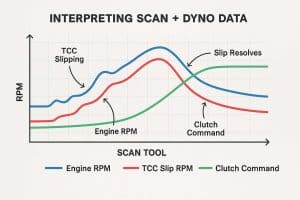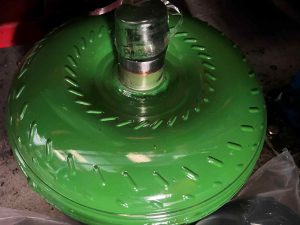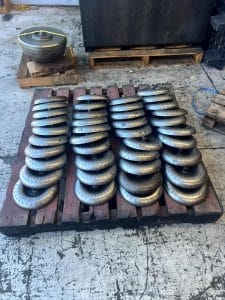Torque Converter Upgrades for Towing and Performance
This page is for people who want to learn about Torque Converter Upgrades. When you think about towing performance, most people picture big engines, strong manual gearboxes, and heavy-duty suspension. Yet convenience and comfort win all the time, and the majority of us tow with automatic transmissions. Typically, upgrades start with just a simple engine tune, “stage 1”, then suspension & GVM upgrade. Yet one of the most critical components — and often the first to fail under load — is the torque converter. For many ute and 4WD owners, especially those with GVM upgrades or performance tunes, the converter becomes a silent weak link. Overheating, shudder, and premature lock-up clutch wear are all too common, and left unchecked, these issues lead to expensive transmission rebuilds.
At Brisbane Tuning & Turbo, we’ve seen firsthand how GVM upgrades and heavy towing strain converters beyond their design limits. This page explains why it happens, the symptoms to watch for, and how a properly matched upgrade can completely transform reliability, drivability, and towing confidence.
How a Torque Converter Works
A torque converter sits between your engine and automatic transmission, acting as both a fluid coupling and a torque multiplier. It allows your engine to idle without stalling the vehicle, provides torque amplification when moving off from a stop, and, when the lock-up clutch engages, creates a direct mechanical connection between engine and transmission for efficiency.
The main components — impeller, turbine, stator, lock-up clutch — all work together to transfer power through transmission fluid. In normal driving, this system works seamlessly. Under heavy towing or with increased engine output, however, fluid shear, heat, and clutch slip start to climb, pushing the converter to its limits.
Why Torque Converters Fail?
Several factors contribute to torque converter failure, but in the context of towing and GVM upgrades, the key culprits are:
Overheating: Excess load generates more heat in the transmission fluid. Above ~120°C, lock-up clutch materials degrade rapidly, and seals start to harden.

Torque Converter Slip
Lock-up clutch wear: Repeated slip under load wears the friction material, causing shudder and eventual failure to engage.
Fluid shear and contamination: High torque causes microscopic wear, sending debris through the transmission and accelerating internal wear.
Inadequate lock-up pressure: Stock converters often have marginal lock-up clamping force for heavy towing loads, leading to persistent slip.
Multiplier effect of upgrades: A GVM upgrade means the vehicle is heavier all the time, not just when towing. Add a performance tune, and the torque load jumps well beyond OEM expectations.
Real-World Impacts
When a converter starts to fail, the symptoms are subtle at first — a slight hesitation on take-off, a faint vibration in lock-up, or higher-than-usual transmission temps. Over time, these escalate into noticeable shudder under load, slipping on hills, limp mode activation, and eventually, transmission failure.
Beyond repair costs, there’s the risk of trip-ending breakdowns. We’ve seen owners lose $12,000+ in combined repair and recovery costs after converter failure on remote towing trips, and frankly, they are people who prey on 4WD community. A converter operating at high slip also robs power, increases fuel consumption, and creates constant heat stress for the gearbox.
Torque Converter Upgrades Options
Stock Replacement:
Suitable only for factory-spec vehicles with light-duty use. It restores operation but won’t address the core weaknesses for towing or tuned applications. Yet, the majority still prefer to rebuild a failed torque converter and use the vehicle the same way as before. We see this choice as money-saving only, and we understand why people decide to follow this option.
Heavy-Duty Converter:
Features include improved lock-up clutch surface area, stronger stator designs, and better internal tolerances. These handle higher torque, reduce slip, and keep temps in check. If your ute is heavy, this is exactly what it needs. Keep in mind that even heavy-duty torque converters fail.

6R80 Rebuild Torque Converter
Billet Torque Converter:
The top tier for extreme towing or high-output builds and 4wd. Fully CNC-machined housings, precision-balanced internals, and upgraded clutch packs make these virtually bulletproof under heavy torque loads. Yet once they can fail to, yet can take the abuse and handle it well.
The right choice depends on vehicle use, current torque output, and towing requirements. For most towing utes, a heavy-duty converter with a matched transmission cooler delivers a massive improvement in drivability and reliability.
The Brisbane Tuning & Turbo Redorq Approach
At Brisbane Tuning & Turbo, we don’t just swap converters — we engineer a complete solution. Every upgrade starts with a Transmission Health Check, which includes a scan for DTCs, live data monitoring, and a full-load dyno test to see exactly how the converter is performing. We listen to what you use your vehicle for and recommend what you need. We weight your vehicle to know the weight of your vehicle to calculate the increased constant demand.

Torque Converters for rebuilds
If an upgrade is recommended, we match the converter specification to the application — whether that’s our Redorq TQ+ Heavy-Duty Converter for AC60F HiLux platforms, a billet option for a 6R80 Ford Ranger or Mazda BT-50, or a towing-focused setup for a Land-Cruiser A750F.
Every converter we install is precision-machined to exact tolerances, balanced, and bench-tested before fitment. We pair each upgrade with a transmission cooler package and, where needed, a transmission control module recalibration to ensure optimal lock-up pressure.
Platform-Specific Notes
AC60F (HiLux/Prado/Fortuner): Common GVM upgrade and towing platform. Stock converter often overheats under load. Our TQ+ upgrade with a cooler package is a proven fix.
A750F Land Cruiser 200: Handles stock torque well but suffers in long-haul towing- this is a heat-soak problem- upgrading with a cooler package & larger pan is recommended. Heavy-duty torque converter recommended for reliability, especially past 200,000 km.
AB60F (V8 LandCruiser 70/200): Massive torque from 1VD-FTV engines means converters run hot under heavy loads. Billet upgrade ensures long-term durability.
6R80 (Ranger/Everest): Known for shudder when tuned or towing. HD converter plus transmission tune & upgrade with cooler package or cooler bypass resolves most issues.
10R80 (PX3 Ranger): Improved design but sensitive to heat. HD converter and cooler package extend life under heavy towing.
6L80 (Holden/LS builds): Common failure point in cammed or boosted setups. Billet upgrade strongly advised with high-stall applications, especially for vehicles with 500 HP plus.
RE5R05A (Patrol): Factory converter is marginal even stock. Single turbo conversions benefit greatly from a matched HD converter.
Torque Converter Upgrades Cost & Value
A quality heavy-duty converter upgrade typically costs between $2,800 and $3,600 installed, depending on the platform. Billet options start from around $3,800. While cheaper replacements exist, they rarely deliver the same lifespan or reliability under towing conditions.
When you factor in the cost of full transmission rebuilds — often $7,000 to $10,000 — plus downtime and trip disruptions, a converter upgrade is one of the best investments you can make for a working or touring vehicle.
Torque Converter Upgrades FAQs
How long should a torque converter last?
In normal use, 200,000 km or more. Under heavy towing or tuned loads, failure can occur in less than 100,000 km if not upgraded, depending on the platform.
Do I need a billet converter?
Only if you’re towing at extreme GVM, running very high torque tunes, or building a performance engine. In our experience, Heavy-duty torque converters cover most needs. Yet, if you can afford and know what you expect from your vehicle, a billet torque converter is the only option.
Will a converter upgrade improve fuel economy?
Yes — by reducing slip and keeping the lock-up engaged more consistently under load.
Do I need a tune after installing a heavy-duty torque converter?
Not always, but a transmission calibration often maximises the benefits.
How quickly can Brisbane Tuning & Turbo do the job?
Most installs are completed within four business days, including cooler fitment and testing.
If you tow heavy, run a GVM upgrade, or simply want peace of mind for your next trip, a torque converter upgrade is one of the smartest investments you can make. Book your Transmission Health Check today and let Brisbane Tuning & Turbo build you a driveline that’s as tough as your travels.
Redorq TQ+ Product Page
Transmission Cooler Service Page